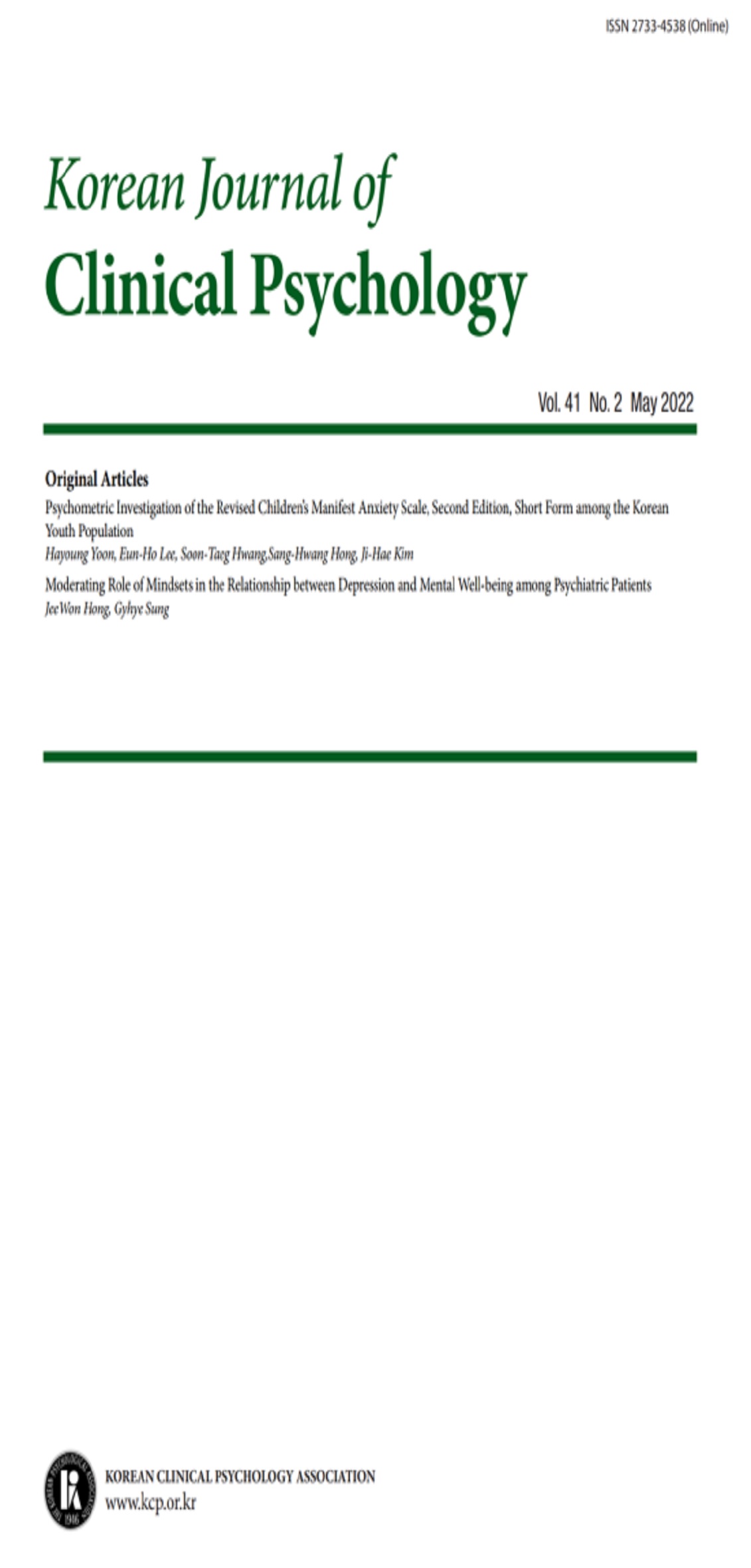open access
메뉴
open access
메뉴 E-ISSN : 2733-4538
E-ISSN : 2733-4538
본 연구는 불안 통제 질문지의 요인구조를 구조화된 진단도구를 통해 불안장애 및 기분장애로 진단된 508명의 정신과 외래 환자와 대학생 및 일반인으로 구성된 469명의 비임상표본을 대상으로 살펴보았다. 먼저 연구 1에서 223명으로 구성된 임상표본 1을 대상으로 탐색적 요인분석을 실시한 결과, 원 30문항 중 19개 문항으로 구성된 3요인 구조가 발견되었다. 다음으로, 연구 1의 표본과 독립적으로 구성된 285명의 임상표본 2를 대상으로 연구 1에서 발견된 3요인 위계구조모형을 경쟁모형들과 확인적 요인분석을 통해 비교하였고, 그 결과 위계적 3요인 구조가 가장 적합한 것으로 나타났다. 마지막으로 연구 1, 2에 포함된 임상표본과 비임상표본을 대상으로 위계적 3요인 구조의 형태동일성과 측정동일성 검증을 실시하였고, 개정된 불안통제 질문지의 위계적 3요인 구조 및 그 요인계수가 임상표본뿐 아니라 비임상표본에서도 동일하다고 밝혀졌다.
This study evaluated the psychometric properties of the revised Korean version of the Anxiety Control Questionnaire (revised K-ACQ) among 508 outpatients with DSM-IV anxiety and mood disorders and 469 non-clinical participants. Exploratory factor analyses produced a 3-factor solution based on 19 of the ACQ’s original 30 items. Confirmatory factor analysis of an independent clinical sample replicated the hierarchical 3-factor solution. Multiple-groups CFA indicated that the measurement properties of the revised K-ACQ were invariant in clinical and nonclinical samples. We discussed these results with regard to their conceptual and psychometric implications for the construct of perceived anxiety control.
오윤희 (2003). 한국판 불안통제 질문지의 신뢰도 및 타당화 연구, 대한 신경정신 의학회 추계 학술대회 초록집.
유상우, 김영신, 노주선, 오강섭, 김찬형, 남궁기 등 (2006). 한국판Mini International Neuropsychiatric Interview 타당도 연구. 대한불안장애학회지, 2(1), 50-55.
이복동, 오윤희, 오강섭 (2004). 사회공포증 환자에 있어 지각된 불안통제감이 사회적 불편감 및 회피정도에 미치는 영향, 인지행동치료, 3(1), 15-27.
조용래, 김은정 (2004). 한국판 불안통제 질문지의 심리측정적 속성. 한국심리학회지: 임상, 23(2), 503-519.
차재호, 공정자, 김철수 (1973). 내-외 통제척도 작성. 한국행동과학연구소: 연구 노우트, 2, 263-271.
최미경, 조용래 (2005). 생활 스트레스와 지각된 불안 통제감 및 대처양식이 대학생의 불안에 미치는 영향, 한국심리학회지: 임상, 24(2), 281-298.
홍세희 (2000). 구조방정식 모형의 적합도 지수 선정기준과 그 근거. 한국심리학회지: 임상, 19, 161-177.
Alloy, L. B., Kelly, K. A., Mineka, S., & Clements, C. M. (1990). Comorbidity of anxiety and depressive disorders: A helpless-hopeless persepective. In J. D. Maser & C. R. Cloninger (Eds.), Comorbidity of anxiety and depressive disorders (pp.499-543). Washington, DC: American Psychiatric Press.
American Psychiatric Association. (1994). Diagnostic and statistical manual of mental disorders(4th ed.). Washington, DC: Author.
Arbuckle, J. L. (2006). Amos (Version 7.0) [Computer Program]. Chicago: SPSS.
Barlow, D. H. (1988). Anxiety and its disorders: The nature and treatment of anxiety and panic. New York: Guilford.
Barlow, D. H. (2002). Anxiety and its disorders: The nature and treatment of anxiety and panic(2nd). New York: Guilford.
Brown, T. A. (2003). Confirmatory factor analysis of the Penn State Worry Questionnaire: Multiple factors or method effects? Behaviour Research and Therapy, 41, 1411-1426.
Brown, T. A., White, K. S., Forsyth, J.P., & Barlow, D. H. (2004). The structure of perceived emotional control: psychometric properties of a revised anxiety control questionnaire. Behavior Therapy, 35, 75-99.
Chorpita, B. F., & Barlow, D. H. (1998). The development of anxiety: the role of control in the early environment. Psychological Bulletin, 124, 3-21.
Floyd, F. J., & Widaman, K. F. (1995). Factor analysis in the development and refinement of clinical assessment instruments. Psychological Assessment, 7, 286-299.
Gregor, K.L. & Zvolensky, M. J. (2008). Anxiety sensitivity and perceivedcontrol over anxiety related events: evaluating the singular and interactive effects in the prediction of anxious and fearful responding to bodily sensation. Behaviour Research and Therapy, 46, 1017-1025.
Hofmann, S. G. (2005). Perception of control overanxiety mediates the relationship between catastrophic thinking and social anxiety in social phobia. Behaviour Research and Therapy, 43, 885-895.
Johnstone, K. A., & Page, A. C. (2004). Attention to phobic stimuli during exposure: the effect of distraction on anxiety reduction, self-efficacy and perceived control. Behaviour Research and Therapy, 42, 249-275.
Rapee, R. M., Craske, M. G., Brown, T. A., & Barlow, D. H. (1996). Measurement of perceived control over anxiety-related events. Behavior Therapy, 27, 279-293.
Sanderson, W, C., Rapee, R. M., & Barlow, D. H. (1989). The influence of an illusion of control on panic attacks induced via the inhalation of 5.5% carbon dioxide enriched air. Archives of General Psychiatry, 46, 157-164.
Sheehan, D. V., Lecrubier, Y., Sheehan, K. H., Janavs, J., Weiller, E., Keskiner, A., Schinka, J., Knapp, E., Sheehan, M. F., & Dunbar, G. C. (1997). The validity of Mini International Neuropsychiatric Interview (MINI) according to SCID-P and its reliability. European Journal of Psychiatry, 12, 232-241.
Sheehan, D. V., Lecrubier, Y., Sheehan, K. H., , Amorim, P., Janavs, J., Weiller, E., Hurgueta, T., Baker, R., & Dunbar, G. C. (1998). The Mini-International Neuropsychiatric Interview (MINI): The development and validation of a structured diagnostic psychiatric interview for DSM-IV and ICD-10. The Journal of Clinical Psychiatry , 59(suppl 20), 22-57.
Zebb, B. J., & Moore, M. C. (1999). Another look at the psychometric properties of the Anxiety Control Questionnaire. Behaviour Research and Therapy, 37, 1091-1103.
World Health Organization(1992). The ICD-10 Classification of Mental and Behavioral Disorders, Geneva, WHO.
